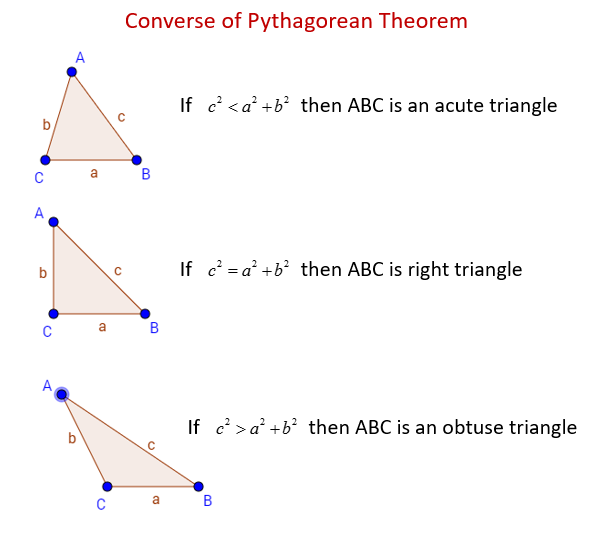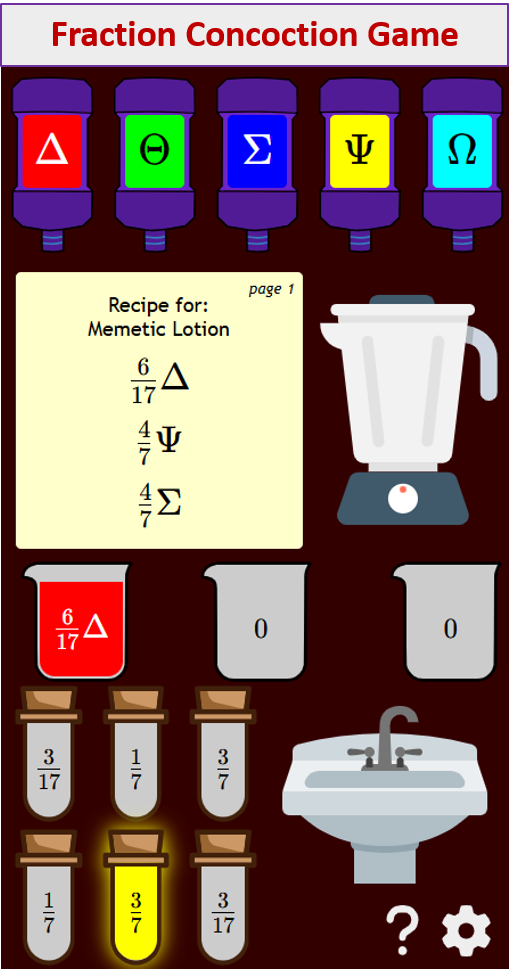The Converse of the Pythagorean Theorem
Related Pages
Pythagorean Theorem
Pythagorean Theorem Word Problems
Applications Of Pythagorean Theorem
More Geometry Lessons
In these lessons, we will learn
- the converse of the Pythagorean Theorem
- how to use the converse to determine whether a triangle is acute, right or obtuse
- how to prove the converse of the Pythagorean Theorem
What is the Converse of the Pythagorean Theorem?
The Converse of the Pythagorean Theorem is a statement that reverses the direction of the original Pythagorean Theorem.
The Original Pythagorean Theorem:
In a right-angled triangle, the square of the length of the hypotenuse is equal to the sum of the squares of the lengths of the other two sides. c2 = a2 + b2
Converse of the Pythagorean Theorem:
If the square of the length of the longest side of a triangle is equal to the sum of the squares of the lengths of the other two sides, then the triangle is a right-angled triangle.
The following figures show the how the Converse of the Pythagorean Theorem can be used to determine the type of triangle. Scroll down the page for more examples, solutions, and proofs of the Converse of the Pythagorean Theorem.

Geometry Worksheets
Practice your skills with the following geometry worksheets:
Printable & Online Geometry Worksheets
The Converse of the Pythagorean Theorem
The Pythagorean Theorem states that
In any right triangle, the sum of the squared lengths of the two legs is equal to the squared length of the hypotenuse.
In mathematical terms: If a triangle has sides of length a, b, and c, where c is the hypotenuse, then a² + b² = c².
The converse of the Pythagorean Theorem states that
For any triangle with sides a, b, c, if a2 + b2 = c2, then the angle between a and b measures 90° and the triangle is a right triangle.
How to use the converse to determine the type of triangle
We can also use the converse of the Pythagorean theorem to check whether a given triangle is an acute triangle, a right triangle or an obtuse triangle.
For a triangle with sides a, b and c and c is the longest side then:
If c 2 < a 2 + b 2 then it is an acute triangle, i.e. the angle facing side c is an acute angle.

If c 2 = a 2 + b 2 then it is a right triangle, i.e. the angle facing side c is a right angle.

If c 2 > a 2 + b 2 then it is an obtuse triangle, i.e. the angle facing side c is an obtuse angle.

Example:
Determine whether a triangle with sides 3 cm, 5 cm and 7 cm is an acute, right or obtuse triangle.
Solution:
We choose the two shorter sides to be a and b and the longest side to be c.
So a = 3, b = 5 and c = 7.
a 2 + b 2 = 32 + 52 = 9 + 25 = 34
c2 = 72 = 49
49 > 34 → c 2 > a 2 + b 2, and so the triangle is an obtuse triangle.
Example:
Determine whether a triangle with sides 12 cm, 14 cm and 18 cm is an acute, right or obtuse triangle.
Solution:
We choose the two shorter sides to be a and b and the longest side to be c.
So a = 12, b = 14 and c = 18.
a 2 + b 2 = 122 + 142 = 144 + 196 = 340
c2 = 182 = 324
340 < 34 → c 2 < a 2 + b 2, and so the triangle is an acute triangle.
Example:
Determine whether a triangle with sides 8 cm, 15 cm and 17 cm is an acute, right or obtuse triangle.
Solution:
We choose the two shorter sides to be a and b and the longest side to be c.
So a = 8, b = 15 and c = 17.
a 2 + b 2 = 82 + 152 = 64 + 225 = 289
c2 = 172 = 289
289 = 289 → c 2 = a 2 + b 2, and so the triangle is an right triangle.
How to use the converse of the Pythagorean Theorem to determine if a triangle is a right triangle?
Triples to memorize
3-4-5, 5-12-13, 8-15-17, 7-24-25
How to use the Pythagorean Theorem and its Converse to determine if a triangle is acute, right, or obtuse?
• Use the Pythagorean Theorem to determine if a triangle is acute, right, or obtuse.
• Use the triangle inequality to determine if a triangle can be formed.
The triangle inequality states that in order to construct a triangle, the sum of the shorter sides must be greater than the longest side.
Examples:
Determine if the lengths represent the sides of an acute, right, or obtuse triangle, if a triangle is possible.
- 7, 24, 25
- 5, 12, 16
- 6, 8, 9
- 3, 5, 9
How to Use the Converse?
- Identify the longest side (c).
- Square all three sides.
- Check if a² + b² = c²
If true, the triangle is right-angled.
If false, it is not a right triangle. - Special case:
If a² + b² < c² then the triangle is acute.
If a² + b² > c² then the triangle is obtuse.
The Converse of the Pythagorean Theorem
This video discusses the converse of the Pythagorean Theorem and how to use it verify if a triangle is a right triangle.
Also, two triangle inequalities used to classify a triangle by the lengths of its sides. Both are related to the Pythagorean Theorem.
Example:
Determine if √13, 10 and 12 make a right triangle.
How to Use the Converse of the Pythagorean Theorem?
How to determine if three given lengths of the sides of a triangle make a right triangle?
This is an application of the Converse of the Pythagorean Theorem.
Example:
The numbers represent the lengths of the sides of a triangle. Classify each triangle as acute, obtuse, or right.
a) 15,20,25
b) 10,15,20
Converse of Pythagorean Theorem
Examples:
-
Specify all values of x that make the statement true.
a) ∠1 is an obtuse angel.
b) The triangle is isosceles.
c) No triangle is possible. -
Explain why x must equal 5.
-
Explain why ∠D must be a right angle.
-
Explain why ∠P must be a right angle.
Proof of the Converse of Pythagoras’ Theorem
Try out our new and fun Fraction Concoction Game.
Add and subtract fractions to make exciting fraction concoctions following a recipe. There are four levels of difficulty: Easy, medium, hard and insane. Practice the basics of fraction addition and subtraction or challenge yourself with the insane level.

We welcome your feedback, comments and questions about this site or page. Please submit your feedback or enquiries via our Feedback page.